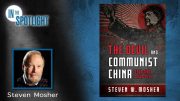
Robert Higgs’ recent (2006) offering, Depression, War, and the Cold War, changes all that in emphatic style. In his latest book, Dr. Higgs, senior fellow in political economy at the Independent Institute and editor of The Independent Review, demolishes a number of orthodoxies about the Great Depression and World War II and examines the transformation of the United States economy and the federal government’s relationship to the private sector during the Cold War. For Higgs, this entire 60-year span of history is of a piece, a multigenerational revolution begun under FDR that saw the role of the federal government utterly transformed, and not for the better.
For the sake of convenience, Higgs parcels the Great Depression into three sub-periods, the “Great Contraction” of 1929-1933, the “Great Duration” of the next decade or so, and the “Great Escape” coinciding approximately with the end of World War II, when the U.S. economy finally and very suddenly returned to robust growth. Of the Great Contraction — the subject of economist Murray Rothbard’s magisterial study of the Great Depression, among many others — Higgs has little to say. Instead, he focuses on the extraordinary length of the Depression, attributing it not merely to the interventionism of the Roosevelt administration per se, but to “regime uncertainty” throughout America, triggered by wholesale attenuation of property rights under the New Deal.
The notion of regime uncertainty is impossible to quantify, but Higgs presents an array of evidence showing the depth of shock, fear, and distrust that FDR’s actions created, especially in the business and investment community. Although we congratulate ourselves nowadays that America in the 1930s did not follow Russia, Germany, Italy, and many other states down the dark road into absolutism, the outcome of the Depression and war years was far less clear to those who lived through them. Many in the business community and among ordinary citizens expected America in the future to be significantly less free than the country they had known before the Depression’s onset, and not a few anticipated outright totalitarianism.
Nor were such fears baseless. In our age of omnipresent federal government — taxing and regulation of the medicines we use, the vehicles we drive, the products we buy, the property we supposedly own, the wages we earn, the food we produce, and the businesses we try to run — it is difficult to imagine the world of pre-1929 (and especially pre-World War I), when the average American never had any contact with the federal government except at the Post Office. The federal government derived nearly all revenues from tariffs on imported goods — mostly luxuries — and such taxes and regulations as then existed on private goods and activities emanated from state and local governments. If a man wanted to start a business, he had only to marshal the private resources to do so. There were no corporate taxes, no Uniform Commercial Code, no federal safety or environmental regulations, and no federal mandates on hiring procedure.
All of that changed with appalling abruptness during the Roosevelt years. Within a few months, the free-market economy that the United States had enjoyed for generations was transformed into a centrally planned command economy, with a welter of New Deal bureaucracies, the end of the gold standard, a regime of price fixing and production controls, and a populist president who publicly and frequently expressed his loathing for private enterprise and his intention to bring wicked capitalists to heel.
Small wonder that many businessmen and investors believed that American economic freedoms would continue to contract drastically. In one national poll conducted in May 1939 cited by Higgs, 56 percent of respondents believed that “ten years from now there will be more government control of business than there is now,” while only 22 percent expected less.
Adding to the uncertainty over FDR’s intentions were his transparent efforts to pack a Supreme Court with cronies who would uphold his entire socialist program. For more than a century and a half, the federal government had operated under more or less constitutional limitations on its power (the period of the Civil War excepted). The so-called “interstate commerce” clause in Article I was interpreted very narrowly, and the Supreme Court, employing a doctrine known as substantive due process, had, until the 1890s — when the spirit of misnamed “progressivism” first began seeking political legitimacy — consistently struck down federal attempts to interfere with private contracting.
In keeping with this long-standing judicial tradition, the Supreme Court indeed struck down FDR’s National Industrial Recovery Act in 1935. But the New Dealers continued with their program under new legislation, and the Supreme Court eventually abandoned substantive due process and supported the expansive interpretation of the interstate commerce clause that remains in force today.
The involvement of the United States in World War II was partly responsible for the revival of the U.S. economy, Higgs argues, but not in the manner usually supposed. The war itself was no stimulus, and the national regimentation associated with the war — the draft, rationing, and the diversion of productive capacity into almost exclusively military channels (planes and tanks were manufactured instead of automobiles, for example) — imposed economic conditions little less harsh than America had endured during the depths of the Depression. Both men and women worked outside the home, and hours were longer. With price controls and few essential consumer goods, like cars, being produced, black markets sprang up to supply various necessaries. Unemployment fell, but that was because a huge portion of the work force — around 18 percent — were drafted or had joined the military voluntarily.
On the other hand, the war forced the federal government to shift its priorities away from domestic welfarism. Most of FDR’s New Dealers were replaced with more conservative individuals deemed better suited to wartime leadership. American households, in the thrall of wartime austerities, began to save more aggressively. By war’s end, political support for the New Deal had cooled, and private savings had grown significantly. Once wartime controls were lifted and government spending cut back, the long-awaited recovery began in earnest, lifting America to new heights of prosperity.
But World War II ushered in the era of the military-industrial complex, a state of permanent mobilization and massive weapons R&D and procurements that has lasted up to the present day. Prior to the war, the production of military weapons was minimal, and few businessmen were willing to risk capital in a sector that was (during the 1930s) widely blamed for encouraging needless American involvement in the First World War, and that was viewed as corrupt and a dishonorable allocation of otherwise productive resources.
With the coming of another world war, the government began subsidizing weapons research and development on a massive scale, and awarding sweetheart-deal contracts whereof payment in full — even for production overruns or unexpected cost overhead — was guaranteed (so-called “cost-plus-fixed-fee contracts”), courtesy of the American taxpayer. Under such conditions, where private profits were covered by public risks, many businessmen who had been previously reluctant to participate in defense contracts were no longer able to resist the temptation.
While it might be argued that such measures were necessary in wartime to mobilize critical industrial resources, the military-industrial complex, along with the massive deficit spending and taxpayer subsidies that it entails, is still with us.
The four-decade Cold War, with its bugbear of nuclear annihilation, was the ultimate windfall for defense contractors and for a federal government determined to keep the United States, politically and economically, on a permanent wartime footing. Here, too, Higgs dares to challenge dogma: why, during four decades in which the United States was involved in no major international shooting war, did the country remain on a wartime footing? Documenting such wasteful measures as the unnecessary purchase of Pennsylvania anthracite coal for shipment to U.S. bases overseas, Higgs shows how the Cold War enabled the federal government to strengthen the socialistic spoils system put in place during the last world war.
It need hardly be added that the so-called War on Terrorism has given the military-industrial complex a new lease on life, little more than a decade after a post-Cold War “peace dividend” was the order of the day.
Depression, War, and Cold War is challenging but essential reading for any who want to truly understand 20th-century economic history, the real causes of the Great Depression, and the relationship between militarism, inflation, taxes, and the expansion of state power.
Depression, War, and the Cold War, by Robert Higgs, Oakland, Calif.: Independent Institute, 2006, 286 pages, paperback. (For ordering information, visit www.ShopJBS.org.)



